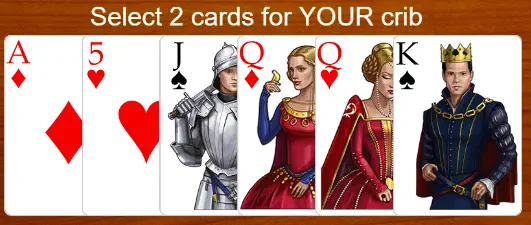Cribbage Strategy - Scores Chances in Cribbage

What Are the Chances of Getting Certain Scores in Cribbage?
There are exactly 26 unique scores that you can get in your cribbage hand: anything from 0 to 29, excluding 19, 25, 26, and 27.
Some of those scores are extremely common; you should expect to get them multiple times per game. Some are exceedingly rare, and you may never see one, even over many years of playing cribbage.
Note: The probabilities for the scores listed here are the probabilities of getting these hands from a random selection of 4 cards and 1 cut. This is not the same as the probability that any individual player will be dealt a hand worth this many points, which depends on how that player plays. A player with any skill should have a greater probability for the higher scores and a lesser probability for the lower scores, as the player gets to pick the first 4 cards from a group of 6. Both forms of probability are approximates.
What Are the Most Common Cribbage Hands?
The bread-and-butter hands in cribbage score 4, 2, and 6, in that order. It’s close between 4 and 2, enough that 4 may be a little more common than 2 if you’re making skilled discards.
Here’s a table of the most common hands, along with their probabilities:
| Score | Chance | Chance |
|---|---|---|
| 4 | 22.0% | 1 in 4.5 |
| 2 | 21.7% | 1 in 4.6 |
| 6 | 13.9% | 1 in 7.2 |
If you feel that you’re constantly getting low-scoring hands like this, you’re not alone. Most of us score this low all the time, simply because it’s more probable.
It’s not unusual to go many hands in a row with nothing but scores in this group. Because of how points are scored in the game—mostly 2 at a time due to pairs and fifteens—it makes sense that the 3 most common scores are even numbers.
Which Cribbage Scores Are Also Common?
The next tier is made up of low and medium scores, as well as no score at all. They’re less common than the bread-and-butter hands, but not massively so.
| Score | Chance | Chance |
|---|---|---|
| 8 | 8.75% | 1 in 11.4 |
| 0 | 7.76% | 1 in 12.9 |
| 7 | 5.78% | 1 in 17.3 |
| 5 | 5.37% | 1 in 18.6 |
| 3 | 3.89% | 1 in 25.7 |
| 10 | 2.99% | 1 in 33.4 |
| 9 | 2.78% | 1 in 36.0 |
| 12 | 2.44% | 1 in 41.0 |
These scores are common enough that you should expect to get a hand from this group once or twice in the average game. Notice that there are finally some odd numbers in there, due to many hands that make these scores including individual runs of 3, nobs, and flushes, rather than only pairs and fifteens.
Which Cribbage Scores Are Rare?
The next group is what you’d call rare hands. If you play with any frequency, you’ll get these from time to time, but not every game. Almost all of them are medium scoring-hands, but if you get one, it will often be the highest score you get in that game—with the exception of naked nobs, worth only 1 point.
| Score | Chance | Chance |
|---|---|---|
| 1 | 0.768% | 1 in 130 |
| 14 | 0.693% | 1 in 144 |
| 16 | 0.448% | 1 in 233 |
| 11 | 0.398% | 1 in 251 |
| 13 | 0.151% | 1 in 662 |
All of the hands in this group include triple runs, quadruple runs, or four of a kind, plus points from pairs and/or fifteens. They’re the types of hands that will take most players a lot of time to count if they’re not using patterns and shortcuts to help.
One very notable score in this group is 20, which is what you get when you catch all four 5s in the deck but fail to catch a 10-value card to go with them. Tragic!
What Are the Rarest Scores in Cribbage?
The scores in this group are astronomically uncommon. Even if you play a lot of cribbage, you could go your entire life without seeing one, particularly the 28 and 29.
| Score | Chance | Chance |
|---|---|---|
| 22 | 0.0034% | 1 in 29,412 |
| 23 | 0.0027% | 1 in 37,037 |
| 28 | 0.0006% | 1 in 166,667 |
| 29 | 0.00003% | 1 in 3,333,333 |
Author - Jim Donahue
Continue Reading...
Quick Counting in Cribbage - Part 1
Quick Counting in Cribbage - Part 2 (this)
Quick Counting in Cribbage - Part 3

JD Software LLC